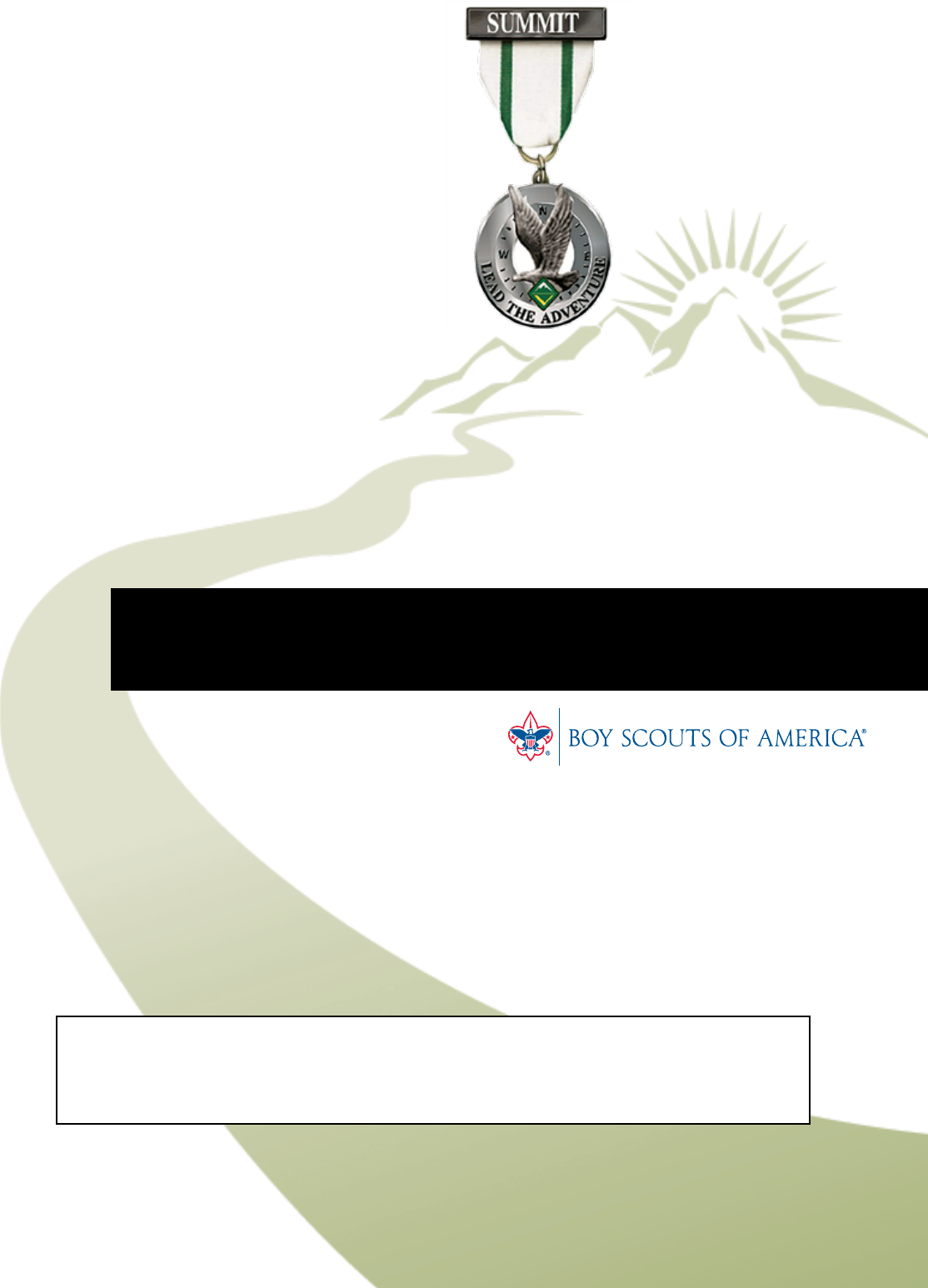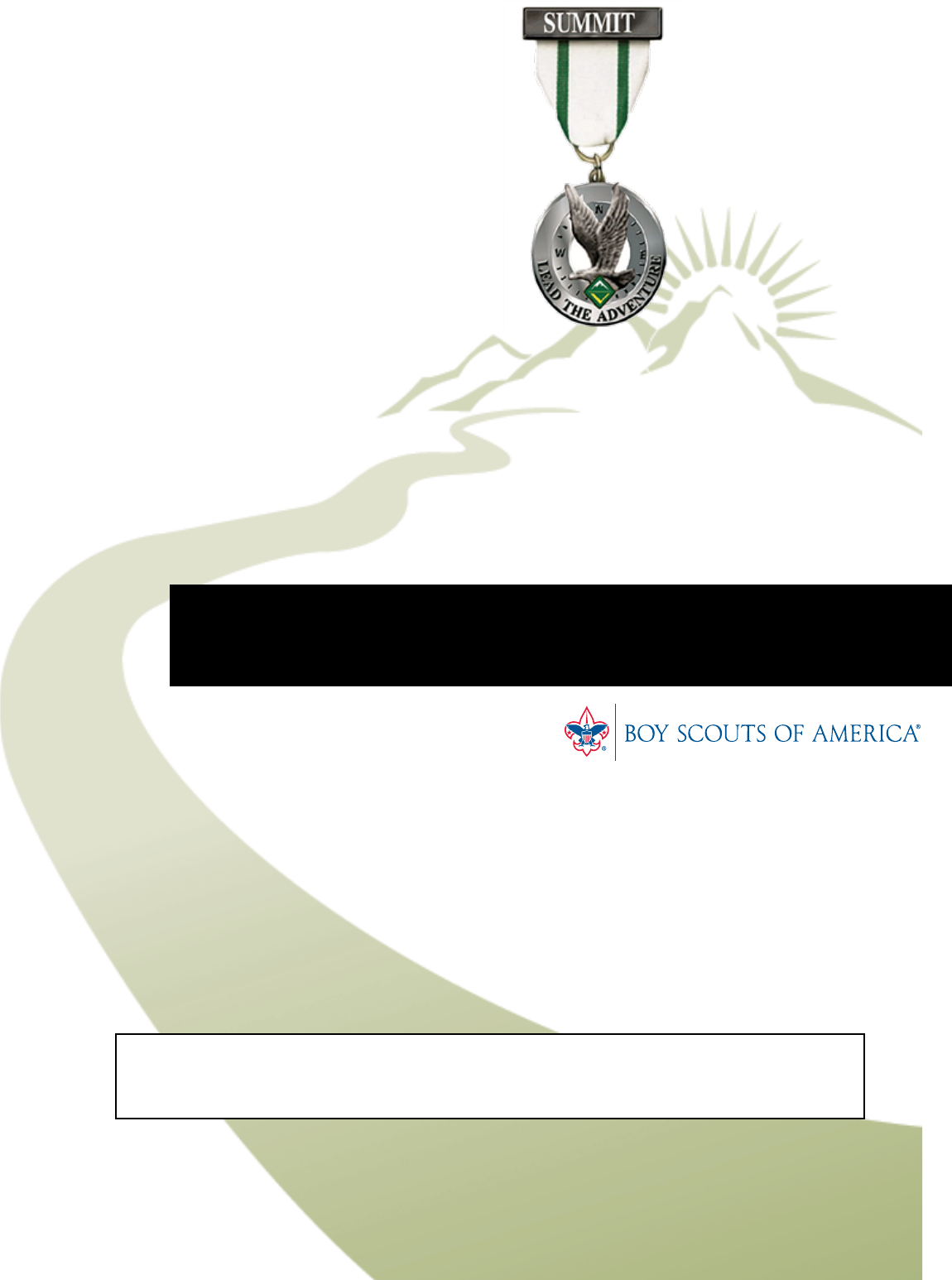
Venturing Summit Award candidate’s full legal name _____________________________________________________
Please give a name to your project ________________________________________________________________________
Only This Ofcial Workbook May Be Used
Venturing Summit Award candidates must use this workbook in completing the Summit Award service project.
This workbook may be copied and distributed; however, no forms or other content may be added or removed,
and no changes may be made to the requirements, text, or graphics included in this workbook.
Ve
nturing Summit Award Service Project Workbook, No. 512-938
October 2022
Venturing Summit Award
Service Project Workbook

Summit Award Requirement 8
Since earning the Pathfinder award, plan and conduct a service project as described in the Venturing Summit Award
Service Project Workbook, No. 512-938. Before you start, have the project proposal form from the workbook completed
and approved by those benefiting from the effort, your Advisor, and another Venturer designated by your crew
leadership. This project must be a different service project than one carried out for the Eagle Scout Award, the Sea
Scout Quartermaster Award, or the Girl Scout Gold Award.
How to Use This Workbook
This workbook includes valuable information that can help ensure success as you begin work on the Venturing Summit
Award service project. It includes three sections or “forms”: a project proposal, a fundraising application, and a project
report. You will need to read this entire workbook if you expect to do a proper job. The proposal and the report are
important to every Summit Award candidate’s project. The fundraising application is required under certain circumstances.
Risk Management, Insurance, and Venturing Service Projects
All Venturing service projects constitute official Scouting activity and thus are subject to BSA policies. The Guide to
Safe Scouting (go to http://www.scouting.org/HealthandSafety/GSS.aspx) and the “Sweet 16 of BSA Safety”
(http://www.scouting.org/HealthandSafety/Sweet16.aspx) apply. Projects are considered part of a crew’s program and
are treated as such with regard to policies, procedures, and requirements associated with Youth Protection,
two-deep leadership, tour plans, etc.
Crew adult leadership has the same responsibility to assure safety in conducting a project as with any other crew
activity. The Boy Scouts of America General Liability Policy provides general liability insurance coverage for official
Scouting activities. Registered adult leaders are provided primary coverage. Unregistered adults participating in
Scouting activities are provided coverage in excess of their personal insurance. Every council has the opportunity to
participate in the BSA accident and sickness insurance program. It provides insurance for medical and dental bills
arising from Scouting activities. If councils do not purchase this, then units may do so. In some cases, chartered
organizations may provide insurance, but this must not be assumed. Most of these programs provide only secondary
coverage, and are limited to registered youth and adults and those interested in membership.
2

Contents
Venturing Summit Award Service
Project Workbook: An Overview 3
Preparing the Project Proposal 3
Planning Your Project 3
When Is the Fundraising Application Needed? 3
The Project Report 3
Choosing a Project 4
Restrictions and Other Considerations 4
Ensuring Safety 4
Workbook Forms
Venturing Summit Award Service Project Proposal Proposal pages A–F
Venturing Summit Award Service Project Fundraising Application Fundraising application pages A–B
Venturing Summit Award Service Project Report Project report pages A–C
Venturing Summit Award Service Project Workbook: An Overview
Preparing the Project Proposal
Your proposal must be completed first, using the proposal form in this workbook. The form must be approved by a
representative of the project beneficiary, your crew Advisor, and a designated Venturer representative from your crew
who reviews Summit Award projects. Summit service projects are evaluated through the application of four focus areas:
service, scope and complexity, leadership, and personal goal connection. However, the impact of the service involved
in a project—the extent to which your project makes a meaningful difference—is the most important consideration.
Planning Your Project
The amount of planning you put into your project will depend on its scope and complexity. For a large-scale project to
be successful, you may find that you will need detailed comprehensive plans. Less complex projects may require only
simplistic planning. If your project does not require you to do very much planning, then you might want to increase its
impact by bringing together and leading a group of people in accomplishing your vision.
When Is the Fundraising Application Needed?
Some service projects will require a fundraising application and others will not. If you do not plan to raise any money or
obtain donated materials or services, or if your fundraising effort involves contributions only from the beneficiary, you,
your parents or relatives, your crew or its chartered organization, or parents of members in your crew, then you do not
need a fundraising application. If you will be obtaining money, materials, or services from other sources, you may need
to submit an application. If you need to submit a fundraising application, it is not required for your proposal. For details,
read “Procedures and Limitations on Venturing Summit Award Service Project Fundraising” on page B of the fundraising
application. Note that fundraising is not a requirement for the Summit Award service project.
The Project Report
Complete the project report after your project has been finished. In it, you will review how your project implemented the
four focus areas and also describe your experiences and what you learned. You must sign the report to confirm that you
planned and completed the project. Note also the signature lines for approvals from the beneficiary’s representative and
your crew Advisor.
3

Choosing a Project
Your project may benefit a religious institution, school, community, or an individual or group, or even that part of a
business’s operation that is provided as a community service. For example, work at a park open to the public that
happens to be owned by a business, or support of a business’s community service efforts could be allowed. The test
is whether the project primarily benefits the community, as opposed to the profits of the business.
Project selection must also take into account the four focus areas that are explained in the proposal form below. A blood
drive, for example, considering its lifesaving impact, could be a good project. In most cases, however, blood banks
provide “canned” instructions. Such a simple project might not be challenging enough or provide enough of a learning
experience. You can make up for this lack in scope and complexity by working with blood bank officials on an approach
that increases impact. This might be organizing a marketing effort, reaching a challenging collection goal, coordinating
multiple events, or giving leadership to a team of volunteers to help with promotion.
An Internet search can reveal hundreds of service project ideas. It might involve construction or conservation, or the
presentation of an event with a worthwhile purpose. It could even encompass designing a helpful computer program,
conducting a research study, or producing instructional audiovisual tools. Talk with your crew Advisor, religious leader,
teachers, or leaders of various community organizations to uncover more ideas.
Restrictions and Other Considerations
Keep the following restrictions and other considerations in mind during the planning process and in carrying out
your project.
• There are no required minimum hours for a project. No one has the authority to tell you otherwise.
• Leadership of others is not required for the Venturing Summit Award service project, though projects that include
leadership may compensate in cases where scope and complexity are relatively simple.
• Routine labor is not normally appropriate for a project. This might be defined as a job or service you may provide as
part of your daily life, or a routine maintenance job normally done by the beneficiary (for example, pulling weeds on the
football field at your school).
• Any limitations on projects for a business are not meant to disallow work for community institutions, such as museums
and service agencies (like homes for the elderly). By their very nature, such entities exist to provide a valuable service to
the community.
• Projects must not be of a commercial nature, and they must not be efforts that primarily raise money, even for a worthy
charity. Fundraising is permitted only for securing materials and facilitating a project, and it may need to be approved
by your council. See the “Summit Award Service Project Fundraising Application” later in this workbook.
• No more than one Summit Award candidate may receive credit for working on the same Summit Award service
project. It is permissible, however, to have projects that are related, as long as each project can be conducted and
evaluated independently.
• Summit Award projects must not include service to the BSA, its councils, districts, units, or properties.
• This project must be different from one you used to fulfill requirements for the Eagle Scout rank, the Sea Scout
Quartermaster rank, or the Girl Scout Gold Award.
Ensuring Safety
Ensuring safety during service projects is always important. As you consider project choices, consult the Guide
to Safe Scouting and the “Sweet 16 of BSA Safety” at http://www.scouting.org/HealthandSafety/GSS/toc.aspx and
http://www.scouting.org/healthandsafety/sweet16.aspx. The latter includes a Service Project Planning Guidelines
worksheet that is useful in planning a safe service project. Besides addressing the usual safety practices, check
specifics about tool use during service projects. Age Guidelines for Tool Use and Work at Elevations or Excavations
chart, No. 680-028, will be helpful in this regard (see http://www.scouting.org/Home/HealthandSafety/Guidelines_
Policies.aspx).
4

Venturing Summit Award candidate’s full legal name _____________________________________________________
Venturing Summit Award service project name ___________________________________________________________
Venturing Summit Award
Service Project Proposal

Contact Information
Summit Award Candidate
Full legal name: Birth date:
Email address: BSA PID No.*:
Address: City: State: Zip:
Preferred telephone Nos.: Pathfinder board of review date:
*Personal ID No., found on the BSA membership card
Crew Information
Crew No. Chartered organization
District name: Council name:
Crew Advisor
Name: Preferred telephone Nos.:
Address: City: State: Zip:
Email address:
Venturing Project Approval Representative
Name: Preferred telephone Nos.:
Address: City: State: Zip:
Email address:
Project Beneciary (Name of religious institution, school, or community)
Name: Preferred telephone Nos.:
Address: City: State: Zip:
Contact person: Title:
Email address:
Instructions for Completing Your Project Proposal
What Is Required
A Venturing Summit Award service project must provide a valuable service that meets a need, and it must represent
a significant personal growth experience through some combination of its scope and complexity, leadership of others,
or a connection to a future personal goal related to your education, career, or other interest. However, the impact
of the service involved in a project—the extent to which your project makes a meaningful difference—is the most
important consideration.
Proposal page A

Summit Service Project Focus Areas: Service, Scope and Complexity,
Leadership, Personal Goal Connection
In determining if your project is acceptable; the following four focus areas will be considered:
Service—A valuable action, deed, or effort carried out to meet a need
Scope and complexity—The scale of the project; the level of effort and planning involved
Leadership—Leading others toward a shared vision
Personal goal connection—Making the most of the experience, including what is important to you
All four focus areas are considered together. Every Summit Award project must provide a service, but no particular level
of scope or complexity is required. Your crew Advisor and a designated crew member must agree that your project
fulfills “What Is Required” above. The other two focus areas, leadership and personal goal connection, are not absolutely
required, but will add great value and depth to your project. While they are optional, one or the other, or both, may help to
compensate for a project that requires little in terms of planning and execution. Leadership of others and a personal goal
connection may also be important to Venturers who wish to provide a project report to a prospective employer or college
admissions board.
Working With Your Project Beneciary
The beneficiary’s approval of your proposal is obtained prior to that of the designated Venturing project approval
representative and crew Advisor. In working with your project beneficiary, it is important to review the following:
• What do the Venturer and the beneficiary expect of each other?
• When will the project begin, and when will it be completed? It must be completed before your 21st birthday.
• The extent of project planning is between the beneficiary and the Venturer. However, the beneficiary has the authority to
determine what kind of planning will be required and to approve the plans before any work begins.
• The beneficiary must obtain any required approvals from its management or governing body; sign any contracts
involved; locate, mark, and protect underground utilities as necessary; obtain any building permits; or meet other
similar requirements.
• The beneficiary is not required to provide any funding for the project, but may do so if desired.
• The Venturer must make it clear to donors or fundraising participants that the money is being raised on the beneficiary’s
behalf, and that the beneficiary will retain leftover funds. If the donor requires a receipt, the beneficiary must provide
one. If the beneficiary is not allowed to retain leftover funds, it should designate a charity to receive them or turn them
over to the Venturer’s crew.
• The beneficiary should have someone on-site to protect its interests. Property owners are responsible for issues
or hazards related to their property or employees, and other individuals or circumstances they would normally be
responsible for controlling. The beneficiary has the authority to stop work at any time.
Next Step: Plan Your Project
Once your proposal is approved, you are encouraged to prepare a written plan for carrying it out. You may get planning
ideas from “Leading and Planning in Venturing” and the “Venturing Activity Planning Worksheet” in the Handbook for
Venturers, chapter 3; and from the Eagle Scout Service Project Workbook at http://www.scouting.org/Home/BoyScouts/
AdvancementandAwards/EagleWorkbookProcedures.aspx. Talk to your crew Advisor, other Venturers, Venturing
consultants available to your crew, and adults or mentors who may have experience with projects like yours. The extent of
planning is up to you and the project beneficiary.
Project Description
Give a brief description of your project and explain why you chose it.
Proposal page B

Focus Area: Service
The Handbook for Venturers, chapter 2, “Venturing Areas of Emphasis,” says, “A service is a valuable action, deed, or
effort carried out to meet a need of an individual, a group of people, or an organization. An act must both be valuable and
address a need of the recipient to qualify as an act of service.”
For a service project to be considered valuable, its impact must have a reasonable level of significance, and it must meet
a specific need. There are many ways in which project impact could be considered “significant.” It might be that it makes
an important difference in peoples’ lives, or changes or even saves lives, or that it provides a level of comfort that most
Americans would consider necessary. A project that allows an organization to make important improvements to its service
might also be considered. Significance could also be achieved through long-term impact, or by preventing or solving
serious problems related to the environment or wildlife, etc.
Explain how your project will provide a valuable or significant impact.
Your project must also meet a “need,” as opposed to a “want.” Remember, however, that one person’s want might be
another person’s need. For example, a “want” to a young person who is fit and healthy may be a need to a person who
is elderly or disabled. A project that is needed might be one that must be done to solve or prevent a serious or even
dangerous problem, or one that provides a necessary level of comfort to those benefiting.
Explain the need that your service project addresses.
Focus Area: Scope and Complexity
Scope and complexity relate to the scale of the project, or the level of effort and planning involved. Your project could
range from small scale requiring a simple plan, to a very large project with a high level of complexity requiring extensive
planning. There is no established requirement for scope and complexity, except that a larger scale project or one that is
more complex may be necessary if your project does not include leadership of others. If on the other hand, you choose a
project that does not require you to do very much planning, you might want to recruit and lead other people who will help
you broaden the project’s impact, or you might want to select a high impact project that also has a strong connection with
a future personal goal.
Describe what plans or direction the beneficiary will provide for you. Explain what you, individually, must plan before you
can begin work, and how long you think it will take to finish your planning.
What kind of resources will be required to complete your project? This can include materials, supplies, equipment, people,
and so forth. Just give your preliminary thoughts; you do not need a detailed list.
Proposal page C

Will you be doing any fundraising or obtaining donations of money, materials, or services? If so, summarize what you
propose to do. Note if you think you will need to submit a fundraising application as your planning progresses.
What sort of safety issues must you consider? See the Guide to Safe Scouting (at http://www.scouting.org/HealthandSafety/
GSS.aspx)
and the “Sweet Sixteen of BSA Safety” (at http://www.scouting.org/HealthandSafety/Sweet16.aspx).
Focus Area: Leadership
The Handbook for Venturers, in chapter 2, “Venturing Areas of Emphasis,” says, “Leadership is about the desire to serve
others. Leaders seek to teach, facilitate, communicate, manage, and yes, persuade others—with the goal of achieving a
vision shared by the leader and the group.”
Leading others toward a common objective is an important skill that Venturing seeks to enhance throughout its
advancement program. It is permissible, however, to choose a Summit Award service project that is conducted through
your own independent effort. Some projects, such as designing a computer application, may have the best outcome
if carried out independently. If no leadership is involved, then you should consider a relatively high level of scope and
complexity to ensure your project represents an acceptable challenge and learning experience.
Will your project require leadership of others?_________________ (If no, skip to the Personal Goal Connection focus area
below. If yes, continue.)
Approximately how many people will you lead?________________(Keep a list of them and hours they work for your report.)
What different kinds of tasks will they perform?
How will you organize and train those who will assist you?
Describe the different kinds of people you will be leading. Are they older, younger, friends, family, skilled, unskilled? What
different leadership styles do you think you will need to use?
Will you delegate leadership authority to others such as a team or group leaders? How will they assist?
Proposal page D

Focus Area: Personal Goal Connection
The Handbook for Venturers, chapter 2, “Venturing Areas of Emphasis,” says, “Goal setting can provide direction
to your time in Venturing and can help you make the most of your experiences by helping you act on what is most
important to you. . . .”
For your Summit Award service project, you may want to look toward your future and consider how the project might
bring you closer to a future personal goal related to your education, career, or other interest. Is it possible that a special
type project in a particular area of study or of a certain magnitude may help in this regard?
Note that it is acceptable to choose a project that has no significant connection with a personal goal. Any service
performed in Venturing is meant to fulfill that part of the Scout Oath, “to help other people at all times,” and also to be a
growth experience. The purpose of the service lies not only in that helpfulness, but also in the examples of service that we
set, and the reward we feel when we give of ourselves. But the experience of the project may also contribute to personal
growth in another very practical way. It may be that your interest in a particular subject will allow you to create a higher
level of impact because your project coincides with that interest. Such a project may help cement your decision to follow
a particular field of study, or it could lead you in a different direction.
There is no penalty to the Venturer who performs a project with no connection to a personal goal. But as “extra credit,”
doing so may help to compensate for a project that is relatively simple in terms of scope and complexity, or that does not
require a great deal of leadership.
Does your project connect with a future personal goal related to your education, a career, or other interest?
Yes/No _________________ (If no, skip to Focus Area Summary below. If yes, continue.)
What is the future personal goal to which your project is connected?
Explain how the project will help you achieve your goal.
Approvals
Summit Award Candidate
On my honor as a Venturer, I have read this entire workbook. I promise to do everything I can to carry out this project as described, and
to generate the best possible result for the beneciary, while maximizing the learning experience for my own personal growth.
Signature ______________________________________________________________________________________ Date ___________________
Project Beneciary
I have discussed this project with the Venturer, and I approve that it may be conducted for our benet. I realize funding is not required of us,
but the Venturer has been informed of the nancial support (if any) we have agreed upon. We understand that any fundraising the Venturer
conducts will be in our name, and that funds left over will come to us as permitted. We will provide receipts to donors as required.
Printed name ___________________________________Signature _____________________________________________ Date ____________
Title __________________________________________________ Name of organization ______________________________________________
Designated Venturer Representative
I have discussed this proposal with the Summit Award candidate. I approve of the described service project, and agree that it provides a
valuable service that meets a need, and represents a signicant personal growth experience through some combination of its scope and
complexity, leadership of others, or a connection to a personal goal.
Printed name ___________________________________Signature _____________________________________________ Date ____________
Crew Advisor
I have discussed this proposal with the Summit Award candidate. I approve of the described service project, and agree that it provides a
valuable service that meets a need, and represents a signicant personal growth experience through some combination of its scope and
complexity, leadership of others, or a connection to a personal goal. I will see that the project is monitored, and that sufcient adults will
be present to ensure the safety of the effort and to maintain all Youth Protection standards.
Printed name ___________________________________Signature _____________________________________________ Date ____________
Proposal page E

Venturing Summit Award Service Project Fundraising Application
Before completing this application, it is important to read “Procedures and Limitations on Venturing Summit Award Service
Project Fundraising” on fundraising application page B. Once completed, you must obtain approval from the project
beneficiary and your crew Advisor, and then submit the fundraising application to your council service center at least two
weeks prior to your fundraising. You will be contacted if it cannot be approved or if adjustments must be made. Use this
form; do not use the Unit Money-Earning Application.
Summit Award Candidate
Name: Preferred telephone Nos.:
Address: City: State: Zip:
Email address: Crew No.
District name: Council name:
Project Beneciary (Name of religious institution, school, or community)
Name: Preferred telephone Nos.:
Address: City: State: Zip:
Email address:
Project Beneciary Representative (Name of contact for the project beneciary)
Name: Preferred telephone Nos.:
Address: City: State: Zip:
Email address:
Describe how funds will be raised or donations of materials or services sought:
Proposed date the service project will begin:
Proposed dates for the fundraising efforts:
How much money do you expect to raise?:
If people or companies will be asked for donations of money, materials, supplies, or tools*, how will this be done and who
will do it?
*You must attach a list of prospective donor names and what they will be asked to donate. This is not required for an event like a car wash.
Are any contracts to be signed? If so, by whom?
Contract details:
See “Procedures and Limitations” following this application.
Approvals The beneciary and crew Advisor sign below, in any order, before authorized council approval is obtained.
Beneficiary Representative Crew Advisor Authorized Council Approval*
Signed Date Signed Date Signed Date
*Councils may delegate approval to districts or other committees according to local practices.
Fundraising application page A

Procedures and Limitations on Venturing Summit Award
Service Project Fundraising
The Summit Award Service Project Fundraising Application must be used in obtaining approval for service project
fundraising or for securing in-kind donations such as supplies or materials.* Send the completed form with any
attachments to your local council service center, where it will be routed to those responsible for approval. This may
be a district executive or another staff member, the council or district advancement committee, a finance committee,
etc., as determined by your council. Only one form is required per service project even if there will be multiple events,
participants, or donors.
*This application is not necessary for contributions from the Summit Award candidate, his or her parents or relatives,
the associated crew or its chartered organization, parents or members in that crew, or the beneficiary. All proceeds
left over from fundraising or donations, whether money, materials, supplies, etc., regardless of the source, go to the
beneficiary. If the beneficiary is not allowed, for whatever reason, to retain any excess funds or materials, etc., the
beneficiary should designate a suitable charity to receive them, or allow the crew to retain them. The unit must not
influence this decision.
If the standards below are met, your fundraising effort likely will be approved.
1. Summit Award service projects may not be fundraisers. In other words, the candidate may not stage an effort that
primarily collects money, even if it is for a worthy charity. Fundraising is permitted only for securing materials, etc.,
and otherwise facilitating a project. Unless the effort involves contributions only from the beneficiary, the Summit
Award candidate, his or her parents or relatives, the associated crew or its chartered organization, or from parents
or members in that unit, it must be approved by the local council. This is achieved by submitting the Summit Award
Service Project Fundraising Application.
2. It must be clear to all donors or event participants that the money, materials, or services are being collected on behalf
of the project beneficiary. Once collected, money raised must be turned over to the beneficiary or to the candidate’s
crew for deposit until needed for the project. If the unit receives the funds, it must release them to the beneficiary once
expenses have been paid.
3. Any contracts must be signed by a responsible adult, acting as an individual, without reference to the Boy Scouts of
America. The person who signs the contract is personally liable. Contracts must not and cannot bind the local council,
the Boy Scouts of America, or the crew’s chartered organization.
4. If something is to be sold, we want people to buy it because it is a quality product, not just because of an association
with Scouting or the Venturing program. Buyers or donors must be informed that the money will be used for a Summit
Award service project to benefit a school, religious institution, community, or other entity as chosen, and any funds left
over will go to that beneficiary.
5. Any products sold, or fundraising activities conducted, must be in keeping with the ideals and principles of the BSA.
For example, they must not include raffles or other games of chance.
6. Should any donors want documentation of a gift, this must be provided through the project beneficiary, not the
Boy Scouts of America. If a donor or fundraising participant wants a receipt, this too must be provided in the
name of the beneficiary.
7. Youth are not normally permitted to solicit funds on behalf of other organizations. However, a local council may allow
an exception for Summit Award service projects.
8. Local councils may determine that certain types of fundraisers such as bake sales and car washes do not require a
fundraising application. Councils may also establish dollar thresholds; for example, “Any effort expected to raise less
than $500 does not require an application.”
Fundraising aplication page B

Venturing Summit Award candidate’s full legal name ___________________________________________
Venturing Summit Award service project name _________________________________________________
Project start date ________________________Project completion date _____________________________
This project report is to be completed after your service project has been concluded. It is not
necessary to provide lengthy answers. Be prepared to discuss your project and this report at your
board of review.
Venturing Summit Award
Service Project Report

Project Overview
Date project proposal approved: ____________________________ Project completion date: ____________________________
Please provide a brief description of your project.
Observations
What went well?
What was challenging?
Changes
Many projects require changes from the proposal. What significant changes did you make? Why? (Be brief.)
Summit Project Focus Area Review
Now that your project is complete, look back on how it reflected the four service project focus areas.
Focus Area: Service
Explain the need that your project met.
Explain the impact of your project. What has been its effect? What makes the service you provided valuable?
Focus Area: Scope and Complexity
Describe the planning that went into your project. Include any research you conducted, consulting you did with others,
action steps outlined, how long it took to plan, and so forth.
What was involved in carrying out your project? How long did it take to carry out, and how did you handle complexities?
What did you learn about planning and carrying out a project?
Project report page A

Focus Area: Leadership It is not required that you lead others in your project; however, doing so may help compensate for a project that is light in scope and
complexity. If you carried out your project independently, you may skip to the next focus area below.
Explain how you provided leadership. Include the number of people you led, and tell a little about them.
What were the most challenging and rewarding aspects of being the project leader?
What did you learn from the leadership experience?
Focus Area: Personal Goal Connection
If you did not connect your project to a future personal goal, skip this section and go to Fundraising below.
What is the future personal goal to which your project is connected?
Is this the same goal as stated in your proposal?_________________ Change is permissible, but please explain why.
How did your project bring you closer to meeting your future personal goal? Be specific.
Fundraising If you did not do any fundraising for your project, skip to Photos and Other Documentation on the next page.
Describe your efforts to raise funds or obtain donations of materials or services.
How much did you collect? ________________________ How much were your expenses? ____________________________
Project report page B

If your expenses exceeded funds collected, explain why this happened and how the expenses were covered.
Leftover funds go to the beneficiary. If the beneficiary cannot accept the funds, to which charity will it go?
Name of charity:
How were the donors thanked?
Photos and Other Documentation If you have them, attach photos taken before, during, and after project completion. You may also
physically attach letters, maps, handouts, printed materials, or similar items. Please list your attachments below.
Follow-Up
Entering Service Project Data
The BSA collects information on hours worked on service projects* because it points to achievement of its citizenship aim. To assist with data
collection, refer to your list of helpers and the hours they worked. Then please provide the information requested below. Include planning time under
“Total Hours Worked.”
Be sure to include yourself and the time you spent on planning.
No. of Workers Total Hours Worked
Summit Award candidate
1
Registered BSA youth members
Other youth (brothers, sisters, friends, etc., who are not BSA members)
Registered BSA adult volunteers and leaders
Other adults (parents, grandparents, etc., who are not BSA members)
Grand total of hours (enter here and on your Summit Award Application)
*There is no requirement for a minimum number of hours that must be worked on a Summit service project.
If you have been told you must meet a minimum number of hours then you may lodge a complaint with your district or council. If you are turned down by
your board of review solely because of a lack of hours, you should appeal the decision.
Candidate’s Promise (Sign before other approvals.) On my honor, I planned and conducted my project as reported here.
Printed name ___________________________________Signature _____________________________________________ Date ____________
Completion Approvals
While all project work must be completed prior to the Venturer’s 21st birthday, signatures may be dated beyond the 21st birthday.
I have provided a letter or other statement that describes the project and its impact (strongly encouraged, but optional).
Yes p No p
Beneciary’s Representative This candidate has conducted this service project to our satisfaction.
Printed name ____________________________________________________________ Title ___________________________________________
Signature _______________________________________________________________Date ___________________________________________
Crew Advisor This Summit Award service project fullls the requirement as stated in this workbook on page 2.
Printed name ___________________________________Signature _____________________________________________ Date ____________
Project report page C
